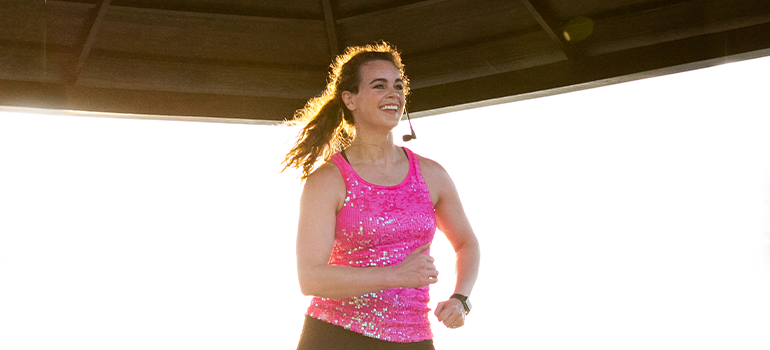Nine long months we wait. During this time, we bond with our unborn child. We watch in awe, and sometimes frustration, as our pregnant body changes and does things, we never imagined possible. But most of all, we anticipate the day we get to meet our little one.
When the big day finally arrives, and your child is placed into your arms for the first time, you feel a flood of emotion.
Having a baby isn’t easy. It’s rewarding and empowering, but not easy. No two birth stories are alike, and when you’re faced with juggling the care of a newborn and your own recovery, things can get tricky. There is no question that recovery from the birth of a child, whether born naturally or via c-section is a process as our bodies shift back into their pre-pregnancy state. In this article, we will dive into the additional challenges that having a cesarean section presents, c-section recovery time, and how to safely ease back into exercise after a c-section.
Before we go there, I’d like to share some statistics. Rates of cesarean section deliveries have been on a steady rise around the world, with occurrences of deliveries via c-section doubling since the year 2000. Here in North America, roughly 32% of all births are c-section deliveries. As common as cesarean sections have become, the fact still remains that if you have delivered your baby via c-section, you’ve just had major surgery! Like all other major surgeries, the weeks following a c-section require plenty of time for proper recovery and healing.
When Can You Exercise After a C-Section?
Due to the surgical nature of a cesarian section, exercise after a c-section may require a more extended waiting period than in vaginal delivery. While you may feel ready to get back into an exercise routine, it’s important to get clearance from your doctor before engaging in a post-c-section workout. If your doctor gives you the green light to return to exercise during your 6-week postpartum appointment, it will still be essential to ease into your routine.
Keep in mind that your postnatal routine may start out feeling very different from your pre-pregnancy regimen, and that’s totally natural. It may take time to build back the core strength and endurance that you had before pregnancy.
“During a c-section, your doctor creates an incision through the abdominal wall to deliver your baby,” explains LadyBoss’Ⓡ pre and postnatal exercise expert Coach Katie Solis. “Recovery from this major surgery takes time, patience, and often a mindset shift: especially for those women who were previously very athletic. All pregnancies and deliveries, whether vaginal or c-section, can cause trauma to the pelvic floor and core muscles, and your 6-week checkup often addresses none of these issues.
“I personally recommend to all of my clients that they consult a Women’s Health or Pelvic Floor Physical Therapist after giving birth to assess for diastasis recti and other common other pelvic floor issues like incontinence and prolapse.”
Safe Exercises Following a C-Section
Exercise after a c-section has two primary functions. It is natural for a new mom to want to gain back the endurance and look that she had before pregnancy. So, how do you get rid of c-section overhang? Sadly, no quick fixes to offer here.
Exercise paired with a healthy diet will help flatten the tummy and slowly get rid of post-c-section overhang. The other and most important factor is the restorative element that gentle exercise provides. Not only are you recovering from a surgical procedure, but the process of carrying a child for nine months creates several changes in your body. The following exercises are safe and gentle. They will allow you to continue to build back up and into your regular prenatal exercise regimen.
Pelvic Floor Exercises After C-section Delivery
You may have already been doing pelvic floor exercises throughout your pregnancy, and if so you know how vital these exercises can be. It’s a common misconception that if you have had a c-section, there is no need for continued pelvic floor exercises postpartum. Your pelvic floor muscles help support your bladder, bowel, and uterus. Your pelvic floor becomes strained by the pregnancy itself. And then during your c-section, the organs mentioned above can take a bit of a hit.
The following are exercises that will aid in C-section recovery by strengthening the pelvic floor:
Kegel exercises. This simple, “invisible to the naked-eye” activity is a fantastic way to regain control of your pelvic floor muscles. The muscles that you use to perform a kegel are the muscles that you would use to stop urination midstream. Once you’ve got your focus on the right muscle group, contract and hold for five seconds, then release. Repeat 10 reps a few times per day.
 Squats. To execute a proper squat, stand with your head facing forward and your chest held up and out. Place your feet shoulder-width apart. Sit back and down like you’re sitting in an imaginary chair. Keep your head facing forward as your upper body bends forward a bit. Rather than allowing your back to round, let your lower back arch slightly as you descend. Lower down, so your thighs are parallel to the floor, keeping your knees over your ankles. Press your weight back into your heels, and push through your heels to bring yourself back to the starting position. Repeat 15-20 times.
Squats. To execute a proper squat, stand with your head facing forward and your chest held up and out. Place your feet shoulder-width apart. Sit back and down like you’re sitting in an imaginary chair. Keep your head facing forward as your upper body bends forward a bit. Rather than allowing your back to round, let your lower back arch slightly as you descend. Lower down, so your thighs are parallel to the floor, keeping your knees over your ankles. Press your weight back into your heels, and push through your heels to bring yourself back to the starting position. Repeat 15-20 times.
 Bridges. The bridge is an excellent exercise for both your pelvic floor muscles and your gluteus muscles. To perform, lay on your back on top of a towel or exercise mat. Plant your feet firmly on the floor, keeping your knees at a 90-degree angle. Push up through your heels, raising your hips off the floor. Be sure to squeeze your gluteus muscles and engage your pelvic floor at the top of the movement. Lower and repeat 10-15 times twice per day.
Bridges. The bridge is an excellent exercise for both your pelvic floor muscles and your gluteus muscles. To perform, lay on your back on top of a towel or exercise mat. Plant your feet firmly on the floor, keeping your knees at a 90-degree angle. Push up through your heels, raising your hips off the floor. Be sure to squeeze your gluteus muscles and engage your pelvic floor at the top of the movement. Lower and repeat 10-15 times twice per day.
Abdominal Exercises After C-section Delivery
As a mom of four, I know that once we get home from the hospital and the dust starts to settle, we get googling. We search “how to get a flat tummy after birth” or “abs exercise after c-section.” It’s totally normal and healthy to want to regain your pre-pregnancy stature, but it takes time. As Coach Rachael mentioned in this article about working out while pregnant, it’s essential to fight the urge to dive back into your prenatal abdominal routine. Below are some gentle abdominal exercises that will begin to strengthen and tone your abdominal wall. This helps you prepare your body for whatever workouts you throw at it in the future.
Side note: Before performing any of these exercises, it’s essential to check for a condition called diastasis recti. Diastasis recti is a condition that occurs post-pregnancy where a gap forms in between the rectus abdominis muscles. While this condition is not considered dangerous, your doctor may recommend a modified exercise regimen for you.
 Pelvic tilts. Deemed as one of the safest abdominal exercises to perform after delivery, pelvic tilts will help begin the process of strengthening the abdominal muscles. To perform a pelvic tilt, lie on your back on a towel or exercise mat. With your feet firmly planted on the floor and your knees at a 90-degree angle, begin to tilt your hips towards your upper body. Be sure to engage your core as you raise your buns about an inch off the floor.
Pelvic tilts. Deemed as one of the safest abdominal exercises to perform after delivery, pelvic tilts will help begin the process of strengthening the abdominal muscles. To perform a pelvic tilt, lie on your back on a towel or exercise mat. With your feet firmly planted on the floor and your knees at a 90-degree angle, begin to tilt your hips towards your upper body. Be sure to engage your core as you raise your buns about an inch off the floor.
Tip: Focus on closing the gap between your lower back and the floor. Hold your position for a few seconds, then release. Repeat 10 times.
 Modified side plank. Changing this movement will allow you to engage your inner core muscles without placing too much strain on your healing abdominal wall. Start by laying down on your side, on top of your towel or exercise mat, keeping your knees bent. Slowly lift into a side plank position, keeping your knees on the floor. Hold for 10-20 seconds. Repeat on the other side.
Modified side plank. Changing this movement will allow you to engage your inner core muscles without placing too much strain on your healing abdominal wall. Start by laying down on your side, on top of your towel or exercise mat, keeping your knees bent. Slowly lift into a side plank position, keeping your knees on the floor. Hold for 10-20 seconds. Repeat on the other side.
 Wall sit. The classic wall sit is a full-body exercise that benefits both your pelvic floor and core. To start, stand with your back against a wall, keeping your feet about shoulder-width apart. Drop into a sitting position keeping your knees at a 90-degree angle. Engage your core muscles as you hold your position as long as you can for up to one minute. Repeat 5 times.
Wall sit. The classic wall sit is a full-body exercise that benefits both your pelvic floor and core. To start, stand with your back against a wall, keeping your feet about shoulder-width apart. Drop into a sitting position keeping your knees at a 90-degree angle. Engage your core muscles as you hold your position as long as you can for up to one minute. Repeat 5 times.
Cardio Exercises After C-Section
Engaging in light cardio is an excellent way to increase endurance postpartum and help you achieve weight loss after a cesarean section.
Below are some safe, low-impact cardio options to kickstart your postpartum health and weight loss journey. Always follow your doctor’s recommendations for your personal situation.
- Walking
- Swimming
- Aqua Aerobics
- Elliptical
- Cycling
Recovery Through Postpartum Exercise
Postnatal exercise is a critical factor in c-section recovery. Committing to a mild to moderate exercise routine will help speed physical healing by providing support to your muscular system and increasing your endurance. Finding time for yourself each day to exercise will also help boost your mental health. New moms that may be suffering from postpartum depression can find benefit in the natural anti-depressant qualities exercise provides.
Every mom’s postpartum journey is different. While the exercises included here are a great way to stimulate the recovery process and reintroduce you to a steady exercise regimen, you may need a more customized approach.
LadyBossⓇ Personal Results Coaches are triple certified and have over 10 years of experience in the health and wellness industry. Find out how we can serve you on your road to recovery and help you achieve weight loss after a cesarean section. As always, these exercises are suggestions, and you should consult with your physician before starting any new exercise program.






















